Modelling the Impact of the Introduction of the EURO 6d-TEMP/6d Regulation for Light-Duty Vehicles on EU Air Quality
Abstract
:1. Introduction
2. Methodology
- Real-world emission factors.
- EDGAR emission inventory, to project emission factors to future vehicle fleets.
- EMEP air quality model, to convert emissions to concentrations.
2.1. Data from the Laboratory and Real-World Emission Factors
2.2. EDGAR Emissions
2.3. EMEP Air Quality Model
2.4. Counterfactual Transport Emission Scenarios
- A Reference Case (REF): Road transport emissions correspond to the state of the fleet in the year 2015, i.e., a mixture of Euro 1 to Euro 6. The light-duty vehicles exhaust emission factors for all pollutants are those contained in the EDGAR inventory, using Tier 2 exhaust emission factor and Tier 3 fuel economy indicators presented in the EEA guidelines released in 2019 and based on the COPERT emissions model [30].
- Scenario 1 (SC1): This counterfactual scenario assumes that all passenger and light-commercial vehicles in the simulated domain were approved under the Euro 6b standard, that is, vehicles approved between 2015 and 2018 following the NEDC test procedure which did not include on-road testing. Exhaust PM, NOx, NH3, and non-methane VOCs (NMVOCS) emission factors of all pre-Euro 6b gasoline light-duty vehicles are changed to the corresponding COPERT emission factors of Euro 6b vehicles, and equivalently for diesel vehicles. The emission factors of vehicles propelled with fuels other than gasoline and diesel (e.g., natural gas, liquified-petroleum gas) are kept unchanged. Emission factors for heavy-duty vehicles, motorcycles, and mopeds also remain unchanged. In short, SC1 aimed at simulating the effect in air quality of renovating the fleet of all light-duty vehicles in Europe to Euro 6b vehicles.
- Scenario 2 (SC2): For this counterfactual scenario, all passenger cars and light-commercial vehicles are assumed to comply with the most recent and stringent type approval regulation applicable to Euro 6d-TEMP or Euro 6d vehicles (EC Regulation 2017/1151 and amendments). Euro 6d-TEMP and 6d vehicles, available in the market since late 2017, need to comply with emission limits in the updated laboratory test procedure (WLTP) and on the road following the Real Driving Emissions (RDE) regulations. In SC2, the exhaust emission factors of PM, NOx, NH3, and NMVOCs for gasoline and diesel light-duty vehicles are the ones estimated by JRC STU, as described earlier. Again, in this scenario, emission factors of light-duty vehicles using fuels other than gasoline and diesel are left unchanged as compared to the reference scenario. SC2 is designed to provide evidence of the effect on air quality of the new WLTP and RDE emissions regulations in Europe.
3. Results
3.1. Emissions Scenarios
3.2. Impact on Concentrations
3.2.1. Nitrogen Dioxide (NO2)
Reference Case versus Scenario 1
Scenario 1 versus Scenario 2
3.2.2. Ozone (O3)
Reference Case versus Scenario 1
Scenario 1 versus Scenario 2
3.2.3. Particle Matter (PM2.5)
Reference Case versus Scenario 1
Scenario 1 versus Scenario 2
4. Conclusions
Supplementary Materials
Author Contributions
Funding
Institutional Review Board Statement
Informed Consent Statement
Data Availability Statement
Conflicts of Interest
References
- World Health Organization. Ambient (Outdoor) Air Pollution. 2021. Available online: https://www.who.int/news-room/fact-sheets/detail/ambient-(outdoor)-air-quality-and-health (accessed on 19 April 2022).
- European Environmental Agency. Air Quality in Europe 2021, Report No. 15/2021; Publications Office of the European Union: Luxembourg, 2021; ISBN 978-92-9480-403-7. Available online: https://www.eea.europa.eu/publications/air-quality-in-europe-2021 (accessed on 19 April 2022). [CrossRef]
- European Environment Agency. Air Quality in Europe—2020 Report, EEA Report No. 09/2020. Available online: https://www.eea.europa.eu/publications/air-quality-in-europe-2020-report (accessed on 19 April 2022).
- Lelieveld, J.; Evans, J.S.; Fnais, M.; Giannadaki, D.; Pozzer, A. The contribution of outdoor air pollution sources to premature mortality on a global scale. Nature 2015, 525, 367–371. [Google Scholar] [CrossRef] [PubMed]
- European Environmental Agency. National Emissions Reported to the UNFCCC and to the EU Greenhouse Gas Monitoring Mechanism 1985–2017, European Environment Agency. 2019. Available online: https://www.eea.europa.eu/data-and-maps/data/national-emissions-reported-to-the-unfccc-and-to-the-eu-greenhouse-gas-monitoring-mechanism-15 (accessed on 19 April 2022).
- World Health Organization. WHO Global Air Quality Guidelines. PARTICULATE Matter (PM2.5 and PM10), Ozone, Nitrogen Dioxide, Sulfur Dioxide and Carbon Mon Oxide. 2021. Available online: https://apps.who.int/iris/bitstream/handle/10665/345329/9789240034228-eng.pdf (accessed on 19 April 2022).
- European Environment Agency. Transport and Environment Reporting Mechanism (TERM) 03. 2021. Available online: https://www.eea.europa.eu/publications/progress-of-eu-transport-sector-1/term-briefing-2018 (accessed on 19 April 2022).
- European Commission. Communication from the Commission to the European Parliament, the Council, the European Economic and Social Committee and The Committee of the Regions, a European Strategy for Low-Emission Mobility, COM(2016) 501 Final. 2016. Available online: https://eur-lex.europa.eu/legal-content/en/TXT/?uri=CELEX:52016DC0501 (accessed on 19 April 2022).
- Anenberg, S.; Miller, J.; Minjares, R.; Du, L.; Henze, D.K.; Lacey, F.; Malley, C.S.; Emberson, L.; Franco, V.; Klimont, Z.; et al. Impacts and mitigation of excess diesel-related NOx emissions in 11 major vehicle markets. Nature 2017, 545, 467–471. [Google Scholar] [CrossRef]
- Oreggioni, G.D.; Mahiques, O.; Schaaf, E.; Duerr, M.; Monforti-Ferrario, F.; Muntean, M.; Guizzardi, D.; Vignati, E.; Crippa, M. The impacts of technological changes and regulatory frameworks on global air pollutant emissions from energy industry and road transport. Energy Policy 2021, submitted.
- European Environment Agency. Air Quality in Europe—2017 Report. Available online: https://www.eea.europa.eu/publications/air-quality-in-europe-2017 (accessed on 19 April 2022). [CrossRef]
- International Energy Agency (IEA). Energy Balance Statistics for 1970–2017. 2019. Available online: https://www.iea.org/data-and-statistics/data-products (accessed on 7 April 2022).
- National Emission Ceiling Directive—Policies and Measures (PaMs) to Reduce Air Pollutants Emissions. Available online: https://www.eea.europa.eu/data-and-maps/dashboards/overview-of-compliant-air-pollution-policies (accessed on 4 April 2022).
- Official Journal of the European Union, L 344. 17 December 2016. Available online: https://eur-lex.europa.eu/legal-content/EN/TXT/?uri=uriserv%3AOJ.L_.2016.344.01.0001.01.ENG (accessed on 19 April 2022).
- Morales, V.V.; Clairotte, M.; Pavlovic, J.; Giechaskiel, B.; Bonnel, P. On-Road Emissions of Euro 6d-TEMP Vehicles: Consequences of the Entry into Force of the RDE Regulation in Europe; SAE Technical Paper 2020-01-2219. 2020. Available online: https://saemobilus.sae.org/content/2020-01-2219/ (accessed on 19 April 2022).
- Bielaczyc, P.; Merkisz, J.; Pielecha, J.; Woodburn, J. RDE-Compliant PEMS Testing of a Gasoline Euro 6d-TEMP Passenger Car at Two Ambient Temperatures with a Focus on the Cold Start Effect; SAE Technical Paper 2020-01-0379. 2020. Available online: https://saemobilus.sae.org/content/2020-01-0379/ (accessed on 19 April 2022).
- Valverde, V.; Giechaskiel, B. Assessment of Gaseous and Particulate Emissions of a Euro 6d-Temp Diesel Vehicle Driven > 1300 km Including Six Diesel Particulate Filter Regenerations. Atmosphere 2020, 11, 645. [Google Scholar] [CrossRef]
- Suarez-Bertoa, R.; Valverde, V.; Pavlovic, J.; Clairotte, M.; Selleri, T.; Franco, V.; Kregar, Z.; Astorga, C. On-Road Emissions of Euro 6d-TEMP Passenger Cars on Alpine Routes during the Winter Period. Environ. Sci. Atmos. 2021, 1, 125–139. [Google Scholar] [CrossRef]
- Selleri, T.; Melas, A.D.; Joshi, A.; Manara, D.; Perujo, A.; Suarez-Bertoa, R. An Overview of Lean Exhaust deNOx Aftertreatment Technologies and NOx Emission Regulations in the European Union. Catalysts 2021, 11, 404. [Google Scholar] [CrossRef]
- Suarez-Bertoa, R.; Mendoza-Villafuerte, P.; Riccobono, F.; Vojtisek, M.; Pechout, M.; Perujo, A.; Astorga, C. On-road measurement of NH3 emissions from gasoline and Diesel passenger cars during real world driving conditions. Atmos. Environ. 2017, 166, 488–497. [Google Scholar] [CrossRef]
- Suarez-Bertoa, R.; Pechout, M.; Vojtíšek, M.; Astorga, C. Regulated and Non-Regulated Emissions from Euro 6 Diesel, Gasoline and CNG Vehicles under Real-World Driving Conditions. Atmosphere 2020, 11, 204. [Google Scholar] [CrossRef] [Green Version]
- Commission Regulation (EU) 2017/1154 of 7 June 2017 Amending Regulation (EU) 2017/1151 Supplementing Regulation (EC) No 715/2007 of the European Parliament and of the Council on Type-Approval of Motor Vehicles with Respect to Emissions from Light Passenger and Commercial Vehicles (Euro 5 and Euro 6) and on Access to Vehicle Repair and Maintenance Information, Amending Directive 2007/46/EC of the European Parliament and of the Council, Commission Regulation (EC) No 692/2008 and Commission Regulation (EU) No 1230/2012 and Repealing Regulation (EC) No 692/2008 and Directive 2007/46/EC of the European Parliament and of the Council as Regards Real-Driving Emissions from Light Passenger and Commercia Vehicles (Euro 6) (Text with EEA Relevance) C/2017/3720. Off. J. Eur. Union 2017, 175, 708–732. Available online: https://eur-lex.europa.eu/legal-content/EN/TXT/?uri=celex%3A32017R1154 (accessed on 15 March 2021).
- Janssens-Maenhout, G.; Crippa, M.; Guizzardi, D.; Muntean, M.; Schaaf, E.; Dentener, F.; Bergamaschi, P.; Pagliari, V.; Olivier, J.G.J.; Peters, J.A.H.W.; et al. EDGAR v4.3.2 Global Atlas of the three major greenhouse gas emissions for the period 1970–2012. Earth Syst. Sci. Data 2019, 11, 959–1002. Available online: https://edgar.jrc.ec.europa.eu/dataset_ap50 (accessed on 19 April 2022). [CrossRef] [Green Version]
- Oreggioni, G.D.; Monforti Ferraio, F.; Crippa, M.; Muntean, M.; Schaaf, E.; Guizzardi, D.; Solazzo, E.; Duerr, M.; Perry, M.; Vignati, E. Climate change in a changing world: Socio-economic and technological transitions, regulatory frameworks and trends on global greenhouse gas emissions from EDGAR v.5.0. Glob. Environ. Change 2021, 70, 102350. [Google Scholar] [CrossRef]
- Crippa, M.; Solazzo, E.; Huang, G.; Guizzardi, D.; Koffi, E.; Muntean, M.; Schieberle, C.; Friedrich, R.; Janssens-Maenhout, G. High resolution temporal profiles in the Emissions Database for Global Atmospheric Research. Sci. Data 2020, 7, 121. [Google Scholar] [CrossRef] [PubMed]
- Thunis, P.; Crippa, M.; Cuvelier, C.; Guizzardi, D.; de Meij, A.; Oreggioni, G.; Pisoni, E. Sensitivity of air quality modelling to different emission inventories: A case study over Europe. Atmos. Environ. X 2021, 10, 100111. [Google Scholar] [CrossRef]
- Simpson, D.; Benedictow, A.; Berge, H.; Bergström, R.; Emberson, L.D.; Fagerli, H.; Flechard, C.R.; Hayman, G.D.; Gauss, M.; Jonson, J.E.; et al. The EMEP MSC-W chemical transport model—Technical description. Atmos. Chem. Phys. 2012, 12, 7825–7865. Available online: https://github.com/metno/emep-ctm (accessed on 19 April 2022). [CrossRef] [Green Version]
- Binkowski, F.; Shankar, U. The Regional Particulate Matter Model: 1. Model description and preliminary results. J. Geophys. Res. 1995, 100, 26191–26209. [Google Scholar] [CrossRef]
- EMEP Status Report. Available online: https://emep.int/publ/reports/2017/EMEP_Status_Report_1_2017.pdf (accessed on 4 April 2022).
- European Environmental Agency. EMEP/EEA Air Pollutant Emission Inventory Guidebook. 2019. Available online: https://www.eea.europa.eu/publications/emep-eea-guidebook-2019 (accessed on 4 April 2022).
- European Environment Agency. Data Visualisations. Available online: https://www.eea.europa.eu/data-and-maps/daviz#b_start=0 (accessed on 4 April 2022).
- Suarez-Bertoa, R.; Astorga, C. Isocyanic acid and ammonia in vehicle emissions. Transp. Res. Part D Transp. Environ. 2016, 49, 259–270. [Google Scholar] [CrossRef]
- Li, B.; Ho, S.S.H.; Xue, Y.; Huang, Y.; Wang, L.; Cheng, Y.; Dai, W.; Zhong, H.; Cao, J.; Lee, S.-C. Characterizations of volatile organic compounds (VOCs) from vehicular emissions at roadside environment: The first comprehensive study in Northwestern China. Atmos. Environ. 2017, 161, 1–12. Available online: https://www.sciencedirect.com/science/article/pii/S135223101730273X (accessed on 19 April 2022). [CrossRef] [Green Version]
- Clappier, A.; Thunis, P.; Beekmann, M.; Putaud, J.; de Meij, A. Impact of SOx, NOx and NH3 emission reductions on PM2.5 concentrations across Europe: Hints for future measure development. Environ. Int. 2021, 156, 106699. [Google Scholar] [CrossRef]
- Thunis, P.; Pisoni, E.; Bessagnet, B.; Wilson, J.; Vignati, E.; De Meij, A.; Mascherpa, A. Urban PM2.5 Atlas; EUR 30829 EN; Publications Office of the European Union: Luxembourg, 2021; ISBN 978-92-76-41917-4. [Google Scholar]
- OECD. Redefining Urban: A New Way to Measure Metropolitan Areas; OECD Report; OECD: Paris, France, 2012; 148p, ISBN 9789264174054. Available online: https://www.oecd.org/regional/redefiningurbananewwaytomeasuremetropolitanareas.htm (accessed on 19 April 2022).
- Jhun, I.; Coull, B.A.; Zanobetti, A.; Koutrakis, P. The impact of nitrogen oxides concentration decreases on ozone trends in the USA. Air Qual. Atmos. Health 2014, 8, 283–292. [Google Scholar] [CrossRef] [Green Version]
- European Environment Agency. Emissions of Air Pollutants from Transport. Available online: https://www.eea.europa.eu/data-and-maps/indicators/transport-emissions-of-air-pollutants-8/transport-emissions-of-air-pollutants-8 (accessed on 4 April 2022).
- Raffaelli, K.; Deserti, M.; Stortini, M.; Amorati, R.; Vasconi, M.; Giovannini, G. Improving Air Quality in the Po Valley, Italy: Some Results by the LIFE-IP-PREPAIR Project. Atmosphere 2020, 11, 429. [Google Scholar] [CrossRef] [Green Version]
- Giechaskiel, B.; Munoz-Bueno, R.; Rubino, L.; Manfredi, U.; Dilara, P.; De Santi, G. Particle Measurement Programme (PMP): Particle Size and Number Emissions Before, During and After Regeneration Events of a Euro 4 DPF Equipped Light-Duty Diesel Vehicle; SAE Technical Paper 2007-01-1944; 2007. Available online: https://www.sae.org/publications/technical-papers/content/2007-01-1944/ (accessed on 19 April 2022).
- Giechaskiel, B.; Riccobono, F.; Vlachos, T.; Mendoza-Villafuerte, P.; Suarez-Bertoa, R.; Fontaras, G.; Bonnel, P.; Weiss, M. Vehicle Emission Factors of Solid Nanoparticles in the Laboratory and on the Road Using Portable Emission Measurement Systems (PEMS). Front. Environ. Sci. 2015, 3, 82. [Google Scholar] [CrossRef] [Green Version]
- Degrauewe, B.; Pisoni, E.; Peduzzi, E.; De Meij, A.; Monforti-Ferrario, F.; Bodis, K.; Mascherpa, A.; Astorga-Llorens, M.; Thunis, P.; Vignati, E. Urban NO2 Atlas; EUR 29943 EN; Publications Office of the European Union: Luxembourg, 2019; ISBN 978-92-76-10386-8. [Google Scholar] [CrossRef]
- Thunis, P.; Clappier, A.; Beekmann, M.; Putaud, J.P.; Cuvelier, C.; Madrazo, J.; de Meij, A. Non-linear response of PM2.5 to changes in NOx and NH3 emissions in the Po basin (Italy): Consequences for air quality plans. Atmos. Chem. Phys. 2021, 21, 9309–9327. [Google Scholar] [CrossRef]
- European Environment Agency. National Emissions Reported to the Convention on Long-Range Transboundary Air Pollution (LRTAP Convention). 2020. Available online: https://www.eea.europa.eu/data-and-maps/data/national-emissions-reported-to-the-convention-on-long-range-transboundary-air-pollution-lrtap-convention-15 (accessed on 19 April 2022).
- Putaud, J.-P.; Pozzoli, L.; Pisoni, E.; Dos Santos, M.S.; Lagler, F.; Lanzani, G.; Dal Santo, U.; Colette, A. Impacts of the COVID-19 lockdown on air pollution at regional and urban background sites in northern Italy. Atmos. Chem. Phys. 2021, 21, 7597–7609. [Google Scholar] [CrossRef]
- Huang, L.; Wang, Q.; Wang, Y.; Emery, C.; Zhu, A.; Zhua, Y.; Yin, S.; Yarwood, G.; Zhang, K.; Lim, L. Simulation of secondary organic aerosol over the Yangtze River Delta region: The impacts from the emissions of intermediate volatility organic compounds and the SOA modeling framework. Atmos. Environ. 2020, 246, 118079. [Google Scholar] [CrossRef]
- Feng, T.; Li, G.; Cao, J.; Bei, N.; Shen, Z.; Zhou, W.; Liu, S.; Zhang, T.; Wang, Y.; Huang, R.-J.; et al. Simulations of organic aerosol concentrations during springtime in the Guanzhong Basin, China. Atmos. Chem. Phys. 2016, 16, 10045–10061. [Google Scholar] [CrossRef] [Green Version]
- Feng, T.; Zhao, S.; Bei, N.; Wu, J.; Liu, S.; Li, X.; Liu, L.; Qian, Y.; Yang, Q.; Wang, Y.; et al. Secondary organic aerosol enhanced by increasing atmospheric oxidizing capacity in Beijing–Tianjin–Hebei (BTH), China. Atmos. Chem. Phys. 2019, 19, 7429–7443. [Google Scholar] [CrossRef] [Green Version]
- Tsimpidi, A.P.; Karydis, V.A.; Zavala, M.; Lei, W.; Molina, L.; Ulbrich, I.M.; Jimenez, J.L.; Pandis, S.N. Evaluation of the volatility basis-set approach for the simulation of organic aerosol formation in the Mexico City metropolitan area. Atmos. Chem. Phys. 2010, 10, 525–546. [Google Scholar] [CrossRef] [Green Version]
- Li, G.; Zavala, M.; Lei, W.; Tsimpidi, A.P.; Karydis, V.A.; Pandis, S.N.; Canagaratna, M.R.; Molina, L.T. Simulations of organic aerosol concentrations in Mexico City using the WRF-CHEM model during the MCMA-2006/MILAGRO campaign. Atmos. Chem. Phys. 2011, 11, 3789–3809. [Google Scholar] [CrossRef] [Green Version]
- Tutuianu, M.; Bonnel, P.; Ciuffo, B.; Haniu, T.; Ichikawa, N.; Marotta, A.; Pavlovic, J.; Steven, H. Development of the World-wide harmonized Light duty Test Cycle (WLTC) and a possible pathway for its introduction in the European legislation. Transp. Res. Part D Transp. Environ. 2015, 40, 61–75. [Google Scholar] [CrossRef]
- Clairotte, M.; Suarez-Bertoa, R.; Zardini, A.A.; Giechaskiel, B.; Pavlovic, J.; Valverde, V.; Ciuffo, B.; Astorga, C. Exhaust emission factors of greenhouse gases (GHGs) from European road vehicles. Environ. Sci. Eur. 2020, 32, 125. [Google Scholar] [CrossRef]
- Valverde, V.; Mora, B.A.; Clairotte, M.; Pavlovic, J.; Suarez-Bertoa, R.; Giechaskiel, B.; Astorga-LLorens, C.; Fontaras, G. Emission Factors Derived from 13 Euro 6b Light-Duty Vehicles Based on Laboratory and On-Road Measurements. Atmosphere 2019, 10, 243. [Google Scholar] [CrossRef] [Green Version]
- O’Driscoll, R.; ApSimon, H.M.; Oxley, T.; Molden, N.; Stettler, M.E.J.; Thiyagarajah, A. A Portable Emissions Measurement System (PEMS) study of NOx and primary NO2 emissions from Euro 6 diesel passenger cars and comparison with COPERT emission factors. Atmos. Environ. 2016, 145, 81–91. [Google Scholar] [CrossRef]
- Suarez-Bertoa, R.; Zardini, A.A.; Astorga, C. Ammonia exhaust emissions from spark ignition vehicles over the New European Driving Cycle. Atmos. Environ. 2014, 97, 43–53. [Google Scholar] [CrossRef]

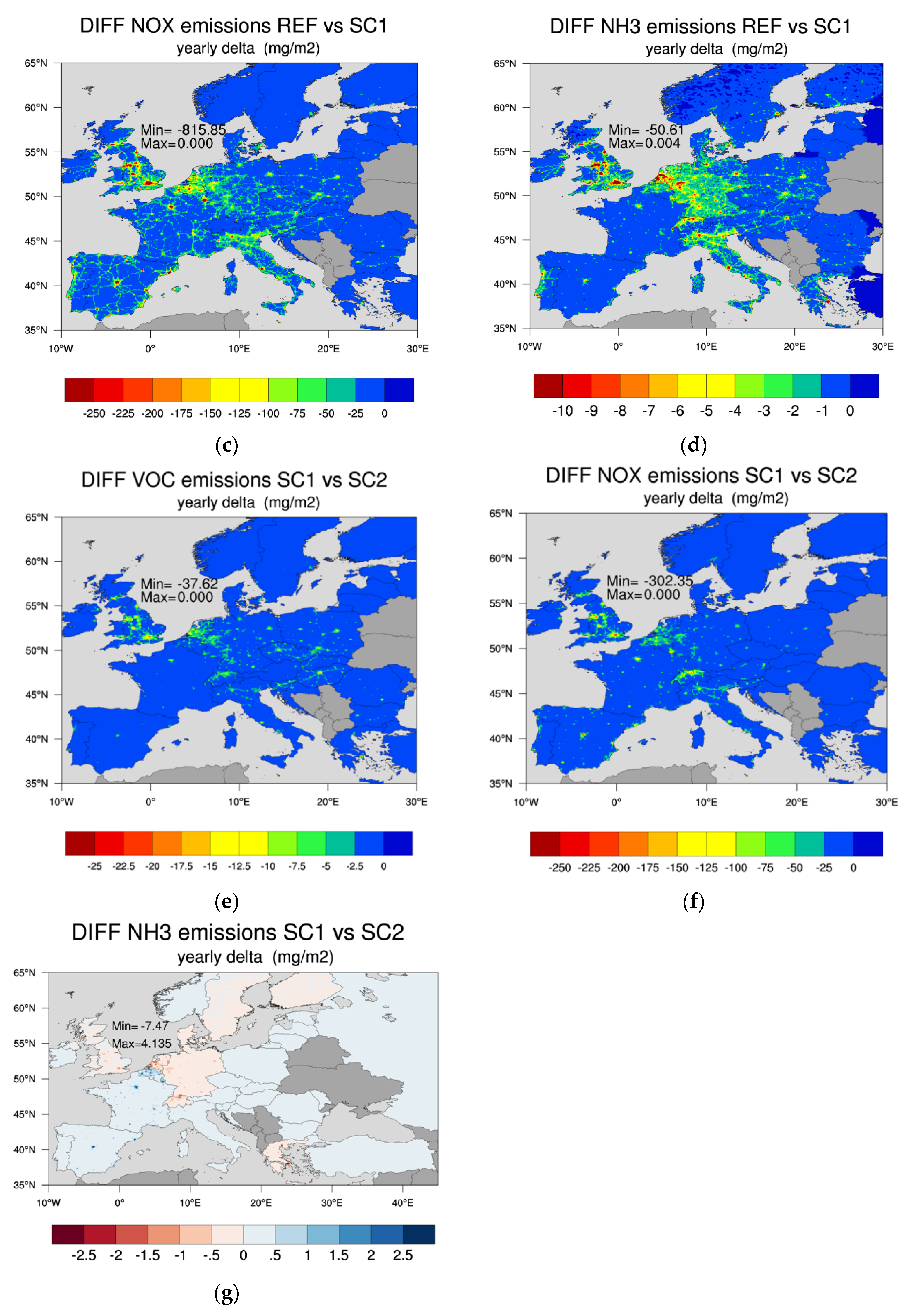
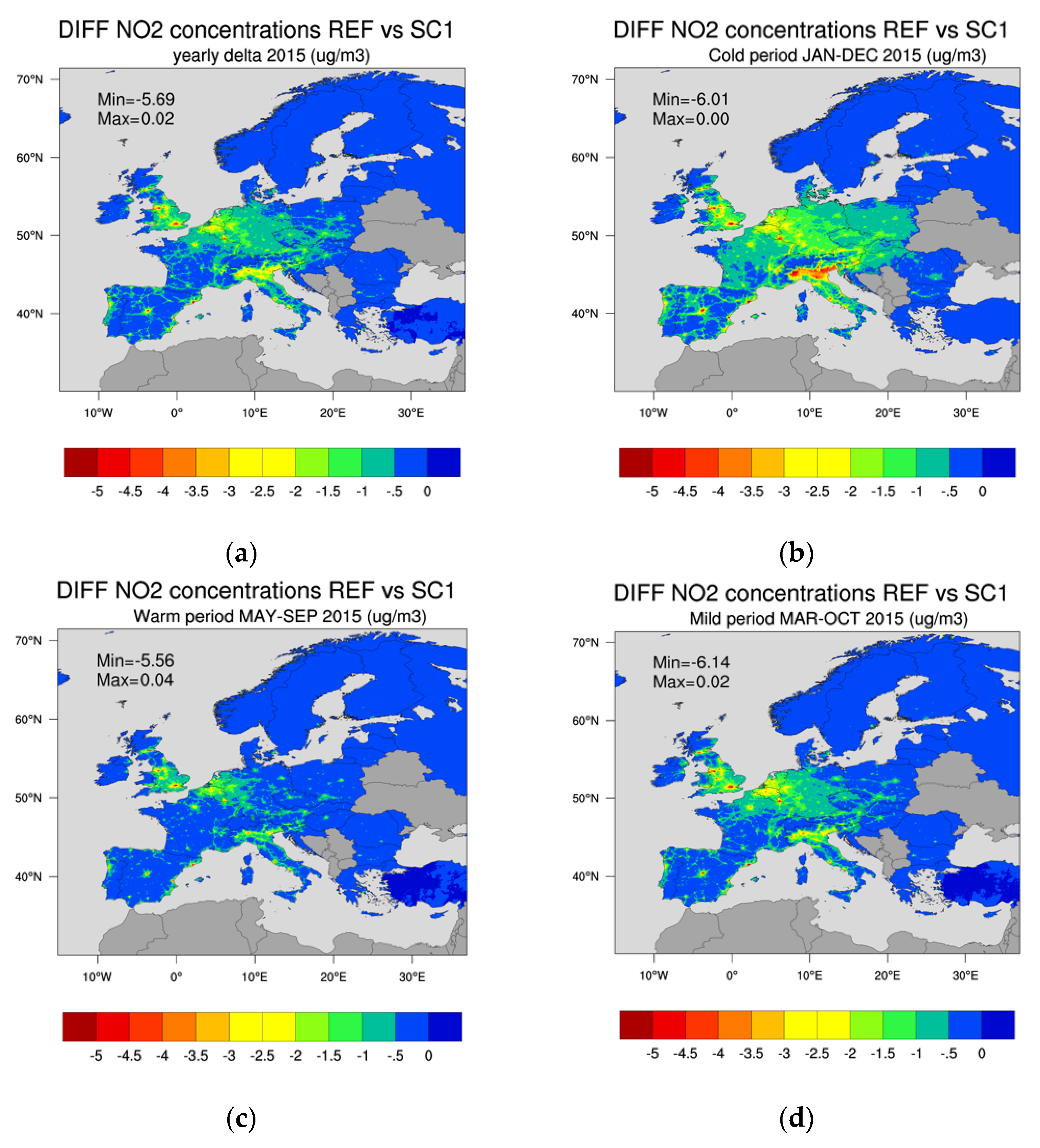

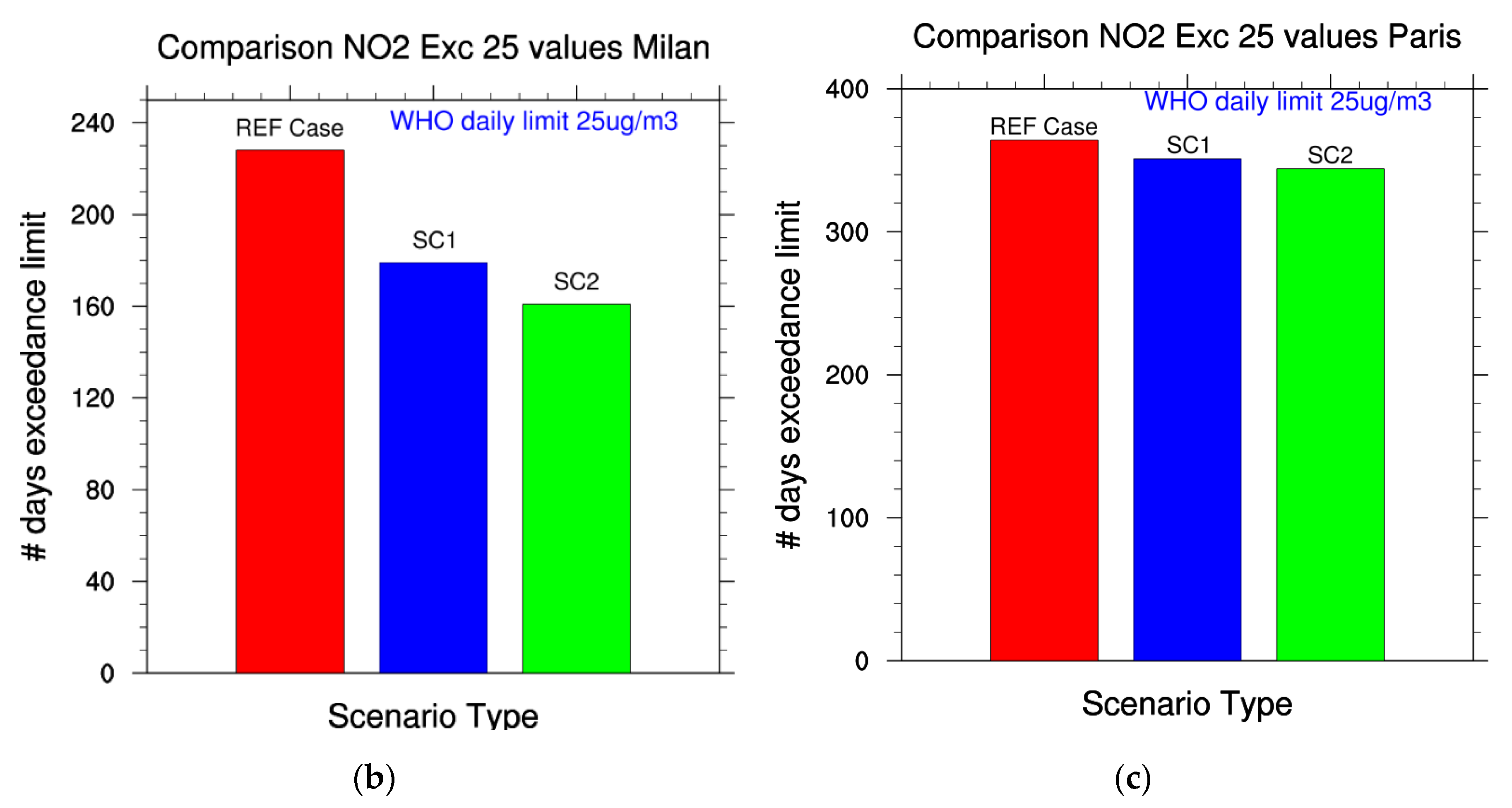
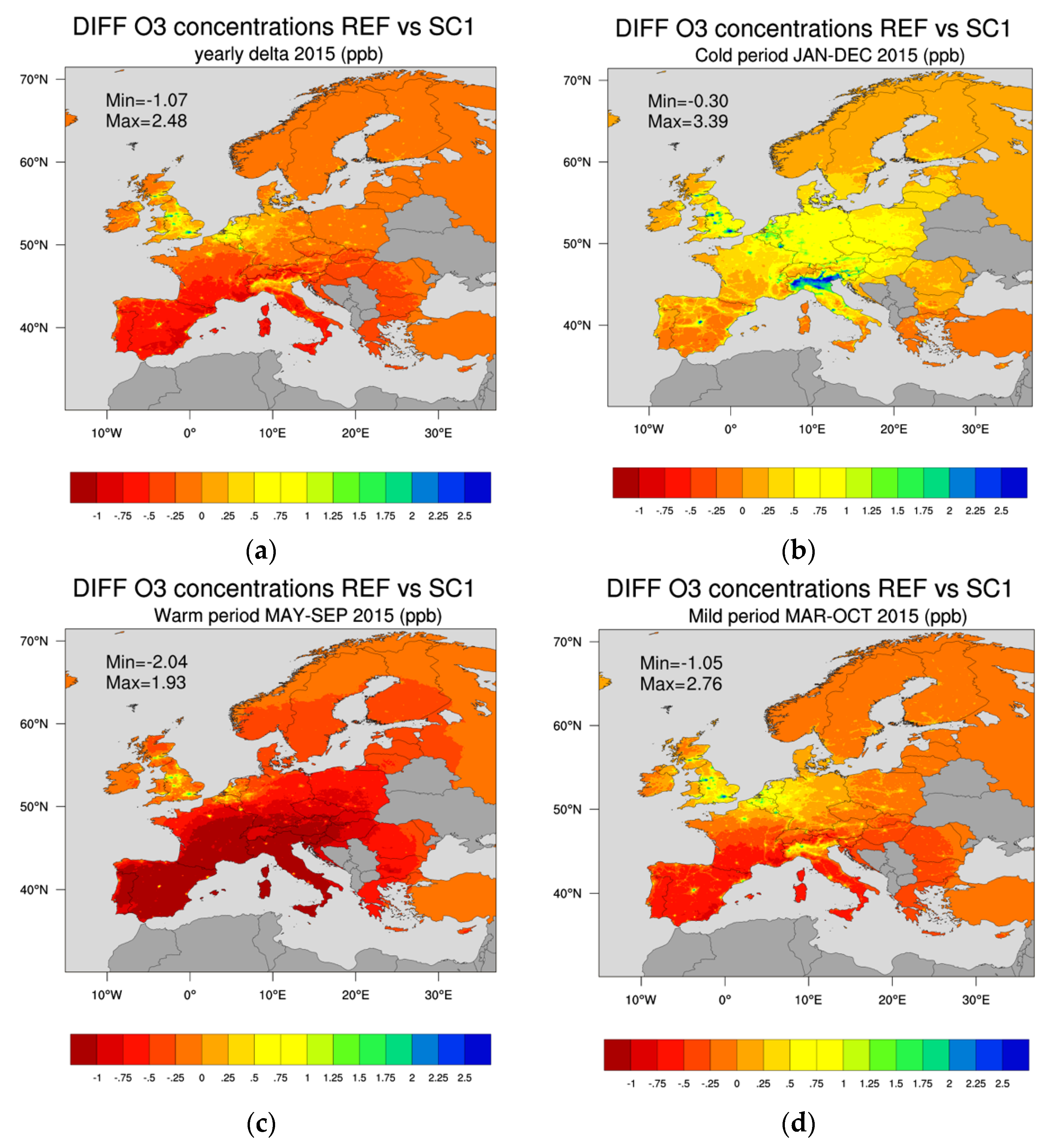
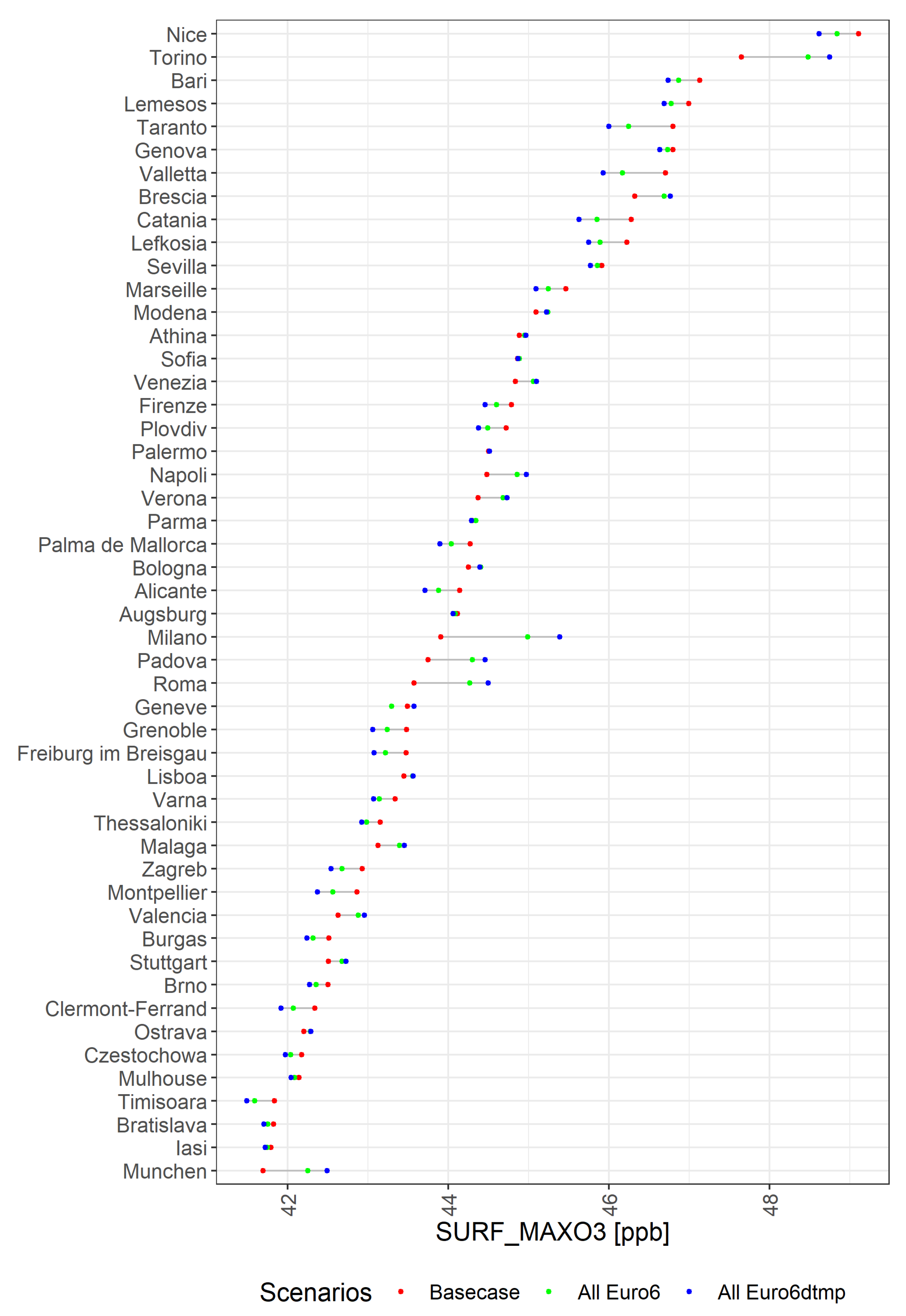
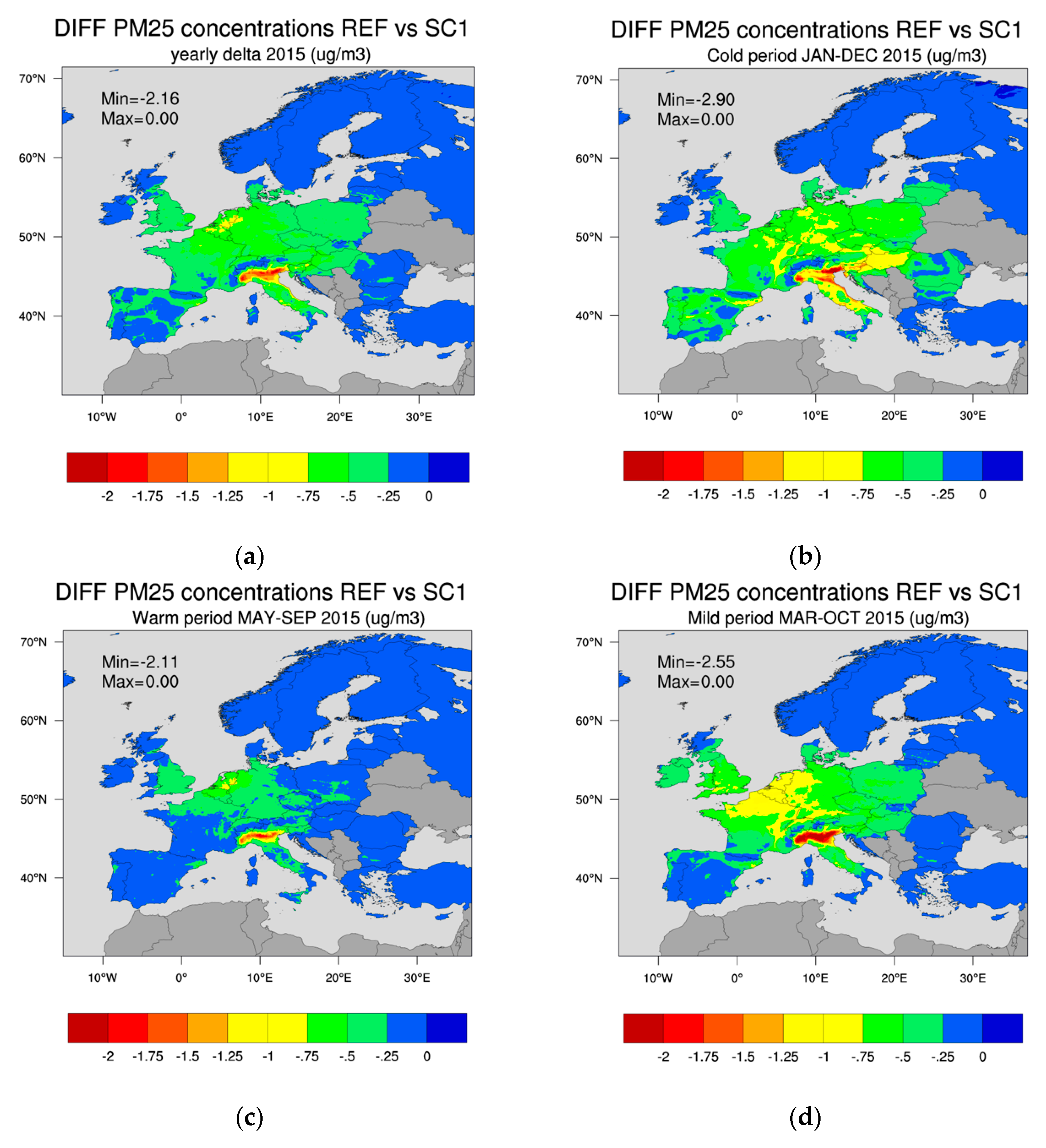
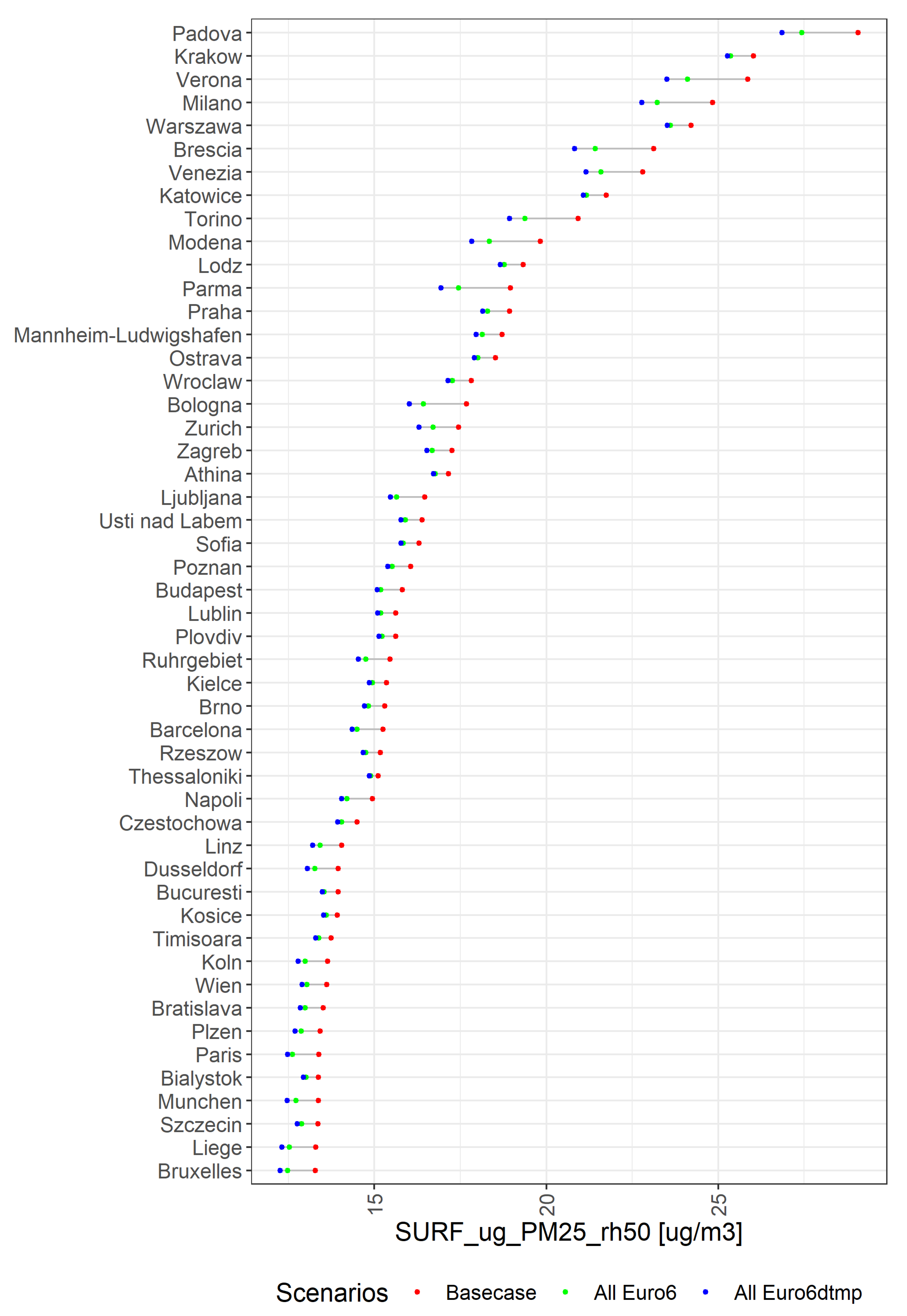

Publisher’s Note: MDPI stays neutral with regard to jurisdictional claims in published maps and institutional affiliations. |
© 2022 by the authors. Licensee MDPI, Basel, Switzerland. This article is an open access article distributed under the terms and conditions of the Creative Commons Attribution (CC BY) license (https://creativecommons.org/licenses/by/4.0/).
Share and Cite
de Meij, A.; Astorga, C.; Thunis, P.; Crippa, M.; Guizzardi, D.; Pisoni, E.; Valverde, V.; Suarez-Bertoa, R.; Oreggioni, G.D.; Mahiques, O.; et al. Modelling the Impact of the Introduction of the EURO 6d-TEMP/6d Regulation for Light-Duty Vehicles on EU Air Quality. Appl. Sci. 2022, 12, 4257. https://doi.org/10.3390/app12094257
de Meij A, Astorga C, Thunis P, Crippa M, Guizzardi D, Pisoni E, Valverde V, Suarez-Bertoa R, Oreggioni GD, Mahiques O, et al. Modelling the Impact of the Introduction of the EURO 6d-TEMP/6d Regulation for Light-Duty Vehicles on EU Air Quality. Applied Sciences. 2022; 12(9):4257. https://doi.org/10.3390/app12094257
Chicago/Turabian Stylede Meij, Alexander, Covadonga Astorga, Philippe Thunis, Monica Crippa, Diego Guizzardi, Enrico Pisoni, Victor Valverde, Ricardo Suarez-Bertoa, Gabriel David Oreggioni, Ornella Mahiques, and et al. 2022. "Modelling the Impact of the Introduction of the EURO 6d-TEMP/6d Regulation for Light-Duty Vehicles on EU Air Quality" Applied Sciences 12, no. 9: 4257. https://doi.org/10.3390/app12094257





